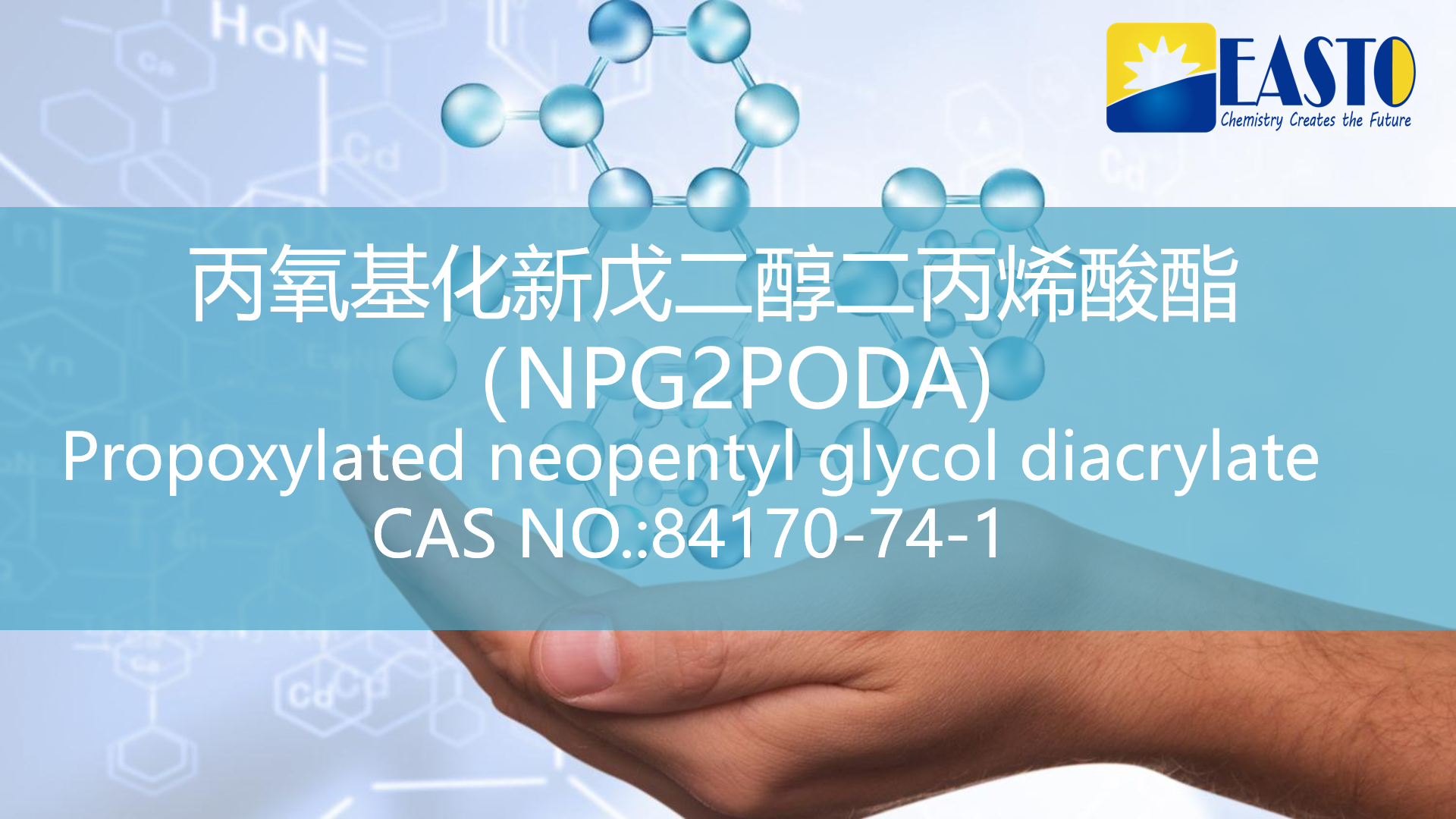The Science and Applications of Propoxylated Neopentyl Glycol Diacrylate (NPG2PODA)(Part 1)
Release time:
2025-05-22
Propoxylated Neopentyl Glycol Diacrylate, commonly identified as NPG2PODA (CAS# 84170-74-1), is a specialized chemical compound that has emerged as a pivotal di-functional acrylic monomer in the realm of advanced materials. This compound serves as a fundamental building block, primarily in polymer and adhesive formulations, and is also recognized by various brand names. Its distinctive properties make it exceptionally valuable across numerous industrial processes, particularly within ultraviolet (UV) and electron beam (EB) curing compositions. This technology is highly regarded for its minimal to zero Volatile Organic Compound (VOC) emissions, presenting a compelling and environmentally conscious alternative to conventional solvent-based systems. The increasing adoption of NPG2PODA is directly linked to the broader industry trend towards sustainability, where materials that facilitate "greener" manufacturing objectives are becoming indispensable. This signifies that the value of NPG2PODA extends beyond its technical performance to its crucial contribution to environmental stewardship and corporate social responsibility, positioning it as an attractive choice for industries navigating complex environmental mandates.
The Molecular Blueprint: Structure and Inherent Properties of NPG2PODA
NPG2PODA's chemical identity is rooted in its full name, Propoxylated Neopentyl Glycol Diacrylate, and its unique CAS# 84170-74-1. Its molecular formula, often broadly represented as (C3H6O)x(C3H6O)y C11H16O4, indicates a variable degree of propoxylation, which influences its molecular weight. The foundational structure is derived from neopentyl glycol, specifically 2,2-dimethylpropane-1,3-diol.
As a di-functional acrylic monomer, NPG2PODA inherently possesses two acrylate groups, which serve as highly reactive sites for polymerization. The "propoxylated" aspect signifies the deliberate incorporation of propylene oxide (C3H6O) units into the neopentyl glycol backbone, resulting in the formation of flexible oligoether acrylate chains. This structural design achieves a delicate balance between rigidity and flexibility. The neopentyl glycol (NPG) core, characterized by its gem-dimethyl groups (2,2-dimethyl structure), introduces significant steric hindrance. This structural feature typically imparts enhanced stability against heat, light, and water, as well as improved resistance to oxidation and hydrolysis in the derived polymers. Conversely, the propoxylated chains, composed of flexible ether linkages, contribute to increased flexibility and a reduction in viscosity. This synergistic dual nature, where the rigid neopentyl core provides stability and the flexible propoxy chains enhance processability and final product properties, is the fundamental reason NPG2PODA can form cured films that are both durable and adaptable. The diacrylate functionality further ensures robust cross-linking during polymerization, leading to a strong, interconnected polymer network.
The unique molecular architecture of NPG2PODA translates into a suite of highly desirable properties for the products it forms:
- Low Viscosity: NPG2PODA is notably characterized by its very low viscosity, typically ranging from 10-20 mPa*s (or cP) at 25°C. This property is paramount for ease of handling, efficient mixing with other components, and precise application, especially in formulations demanding high fluidity.
- Low Volatility: It exhibits very low volatility, a significant advantage for minimizing VOC emissions, thereby contributing to environmental compliance and enhancing workplace safety.
- Fast Curing: NPG2PODA facilitates rapid cure speeds, particularly when utilized in UV/EB curing systems.3 This directly translates into increased manufacturing productivity and improved energy efficiency.
- Improved Flexibility and Adhesion: Its incorporation significantly enhances the flexibility and adhesion of cured products to a wide array of substrates. This attribute is critical for coatings and adhesives that must endure mechanical stress and maintain their structural integrity over time.
- Low Shrinkage: NPG2PODA contributes to minimal shrinkage during the polymerization process. This is a crucial benefit, particularly in applications such as 3D printing, where dimensional stability and precision are paramount.
- Good Chemical Resistance: Cured resins containing NPG2PODA demonstrate commendable chemical resistance to various acids, bases, and solvents.
- Water Solubility: It possesses moderate water solubility, reported as 293 mg/L at 20°C.
- Other Physical Properties: NPG2PODA typically presents as a clear, colorless to slightly yellow liquid. Its density ranges from approximately 1.007-1.010 g/mL at 25°C. The flash point is notably high, exceeding 149°C or 230°F. Its glass transition temperature (Tg) is around 32°C.
The synergistic combination of low viscosity, high reactivity (fast curing), and low shrinkage is a profoundly impactful set of properties. Low viscosity facilitates superior flow and penetration, which is indispensable for achieving intricate designs and high resolution in 3D printing.13 Fast curing drastically accelerates production cycles. Crucially, low shrinkage minimizes internal stresses and deformations within the final cured product, thereby improving dimensional accuracy and overall mechanical integrity, a particularly vital feature for high-resolution 3D printing and durable coatings. This interconnectedness signifies that NPG2PODA is not merely a monomer with a collection of individually good properties, but rather one whose attributes collectively optimize and enable complex, high-precision manufacturing processes. This unique combination positions NPG2PODA as a material of choice for cutting-edge manufacturing techniques like 3D printing, where precision, speed, and the integrity of the final material are non-negotiable. It allows for the creation of complex geometries and high-performance parts that would otherwise be challenging or impossible to achieve with alternative materials.
Table 1: Key Physical and Performance Properties of NPG2PODA
Property | Value |
CAS No. | 84170-74-1 |
Molecular Formula | (C3H6O)x(C3H6O)y C11H16O4 |
Molecular Weight | 216-516 g/mol (UVCB ); ~328 g/mol |
Physical State | Liquid |
Color | Clear, colorless to slightly yellow |
Viscosity (at 25°C | 10-20 mPa*s (cP) |
Density (at 25°C) | 1.007-1.010 g/mL |
Flash Point | >149°C or >230°F |
Water Solubility (at 20°C) | 293 mg/L |
Glass Transition Temperature (Tg) | ~32°C |
Key Performance Attributes | Low Volatility, Fast Cure, Improved Flexibility, Enhanced Adhesion, Low Shrinkage, Good Chemical Resistance |
NPG2PODA
Latest News
Get a Free Consultancy
NANTONG EASTO MATERIALS TECHNOLOGY CO.,LTD.

No.118,Zhujiang Rd.,Juegang St.,Rudong County,
Nantong City,Jiangsu Province,226400,China




 2025-05-27
2025-05-27






